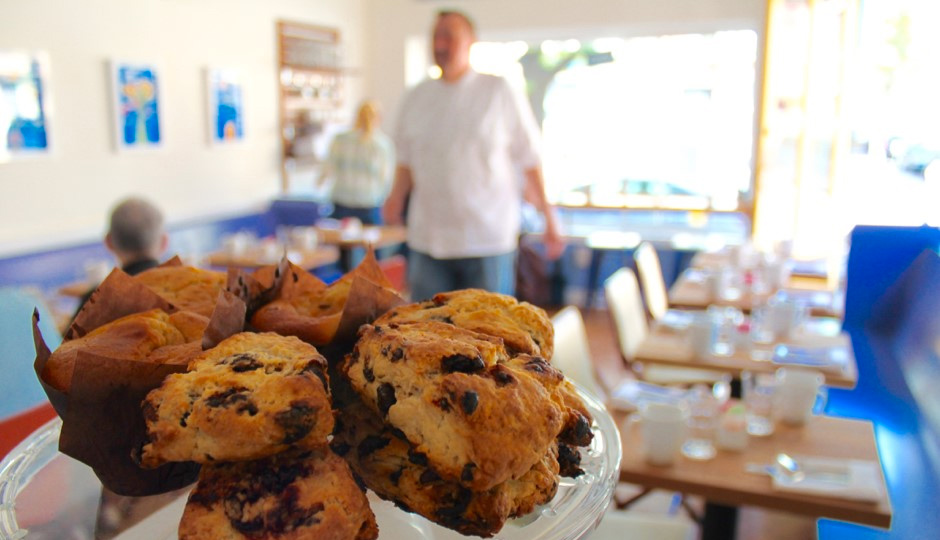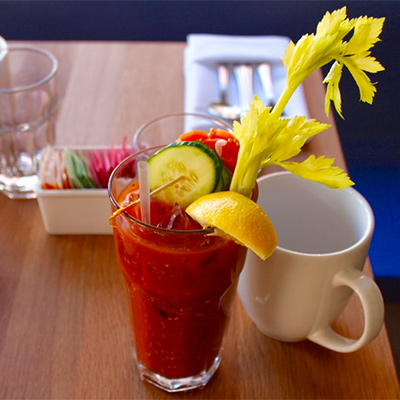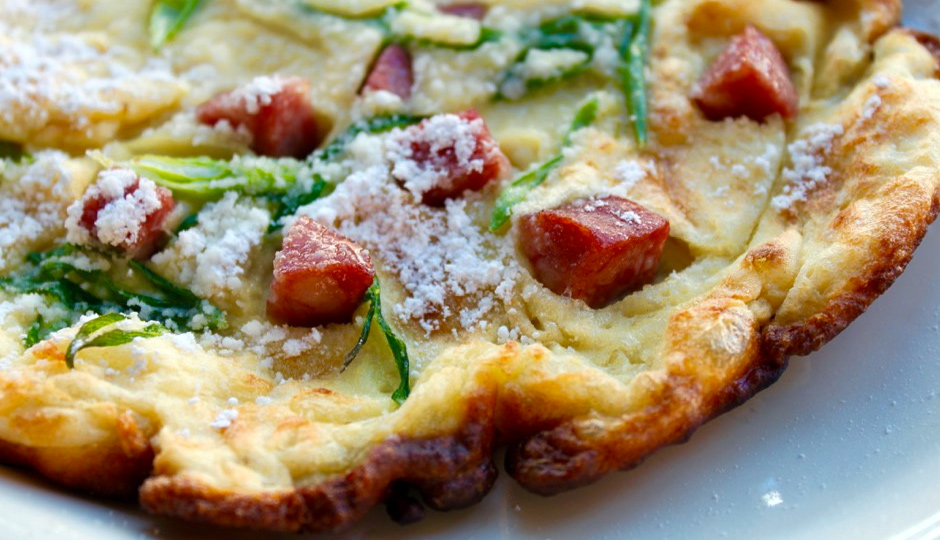Breakfast of Champions: The Dutch Reviewed

The Dutch | Photo by Emily Teel
Breakfast is the last great, untouched frontier. Of all the meals available to us (lunch, dinner, supper, elevenses, fourthmeal, midnight snacks, etc.), breakfast is the most pure, the most un-fuck-with-able. No one in his right mind tries to innovate during breakfast. No one tries to dazzle you with technical wizard-powers or supply lines to long-lost fruits and vegetables. Breakfast is toast and jelly. Coffee. Pancakes. Eggs and bacon. Waffles in all their myriad glories. It is, occasionally, oatmeal. Complicated (but comforting) pastries. Half a grapefruit doused in Wild Turkey. Whatever.
I love congee and chilaquiles as much as anyone, but Americans own breakfast the way the French do dinner. We have stolen all the great ideas ever had about breakfast and made them our own. Americans are so good at breakfast that our canon doesn’t extend merely to regional variations, but to social, religious, economic and historic ones as well. The trucker’s breakfast is a thing. The yoga breakfast. The camp breakfast. The Lutheran pancake social or Continental or Southerner’s petit déjeuner. Breakfast knows no bounds save temporal. And brunch? Well, brunch doesn’t even have those rules to adhere to. Brunch laughs at the notion of rules.
On 4th Street in Pennsport, in a cozy corner space that was once, briefly, home to the restaurant 4th & Cross, we now have the Dutch—a collaborative experiment in the boundaries of breakfast (and brunch) affection being carried out by two guys who probably have better things to do with their time. Lee Styer worked at Lacroix and Le Bec-Fin and is now chef-owner of Fond, a very serious modern French restaurant where duck hearts and Okinawan sweet potatoes are things that people eat. Joncarl Lachman owns Noord and Neuf, giving Philadelphians tastes of Northern European, Dutch and French-North African food. They are big deals and nice guys, and both are very good (and very successful) at what they do. Busy, too, one would presume.
So is it weird that these two now flip eggs and sling bacon and make waffles? That they’re pushing a vision of Pennsylvania Dutch breakfast history and walking the bright, airy, sunlit space all morning pouring coffee and wishing their neighbors a good morning?
Yes, it absolutely is. And also: no, not at all. It’s weird because even if weekend brunches are a thing Philadelphians go bonkers over, a daily breakfast is something ignored by most chefs, considered dull or pedestrian or not profitable or all three at once. And yet, there is in breakfast a clarity and simplicity that can be remarkably attractive to chefs who remember that their first duty is to feed the neighbors, not their egos.
Here are five things that Styer and Lachman are doing right at the Dutch (and one thing I wish they could do better):
They’re Doing What They Love
Styer grew up outside Reading, in Pennsylvania Dutch country. He’s a man with a deep and abiding understanding of Lebanon bologna. Lachman has roots that stretch back to the Netherlands. He knows how to pronounce “uitsmijter” without sounding like a fool—a skill I do not yet possess. These guys have restaurants close by each other. They’ve known each other for years. And they both loved the idea of doing a restaurant that celebrated breakfasts and a style of cuisine they grew up with.
They’re Doing What the Neighbors Love
That uitsmitjer, by the way? One of the servers explained to me that it’s basically Dutch for “The Bouncer”—the guy who boots you out the door when you’ve had too much to drink. It’s sunny-side-up eggs over rye toast and gouda, with crisp, salty, greasy shards of 1732 Meats guanciale and a simple salad of bitter greens and pickled onions, and I get it. It’s a plate made for the morning after. Something that can get you up and out the door. There’s no complication there (besides the name), no barrier to entry (besides the name). It’s one of the Dutch’s most popular dishes.
It’s the same with the omelets (the sandwiches of the breakfast world). There are just three of them. The roasted mushroom is woodsy and perfectly paired with taleggio and truffle oil. The PA Dutch entry here is the Lebanon bologna, crisped on the flat grill and tossed into the mix with eggs and soft, sour farmer cheese.
The entire menu is one page, widely spaced, one side only. There are salads (pricey, but entrée-sized), and every day the kitchen runs specials—soups and sandwiches and whatever else interests the chefs, handwritten on a long roll of butcher’s paper hung from the wall. This is solid, hearty, comforting food with no pretension—an impression that’s reinforced by the bright blue church pews, the folding chairs, the flower paintings hung on the walls. You can’t act cooler than you are when your dining room looks like the set of a very polite Midwestern cooking show. When you’re serving a three-scoop “House Salad Trio” of potato, tuna and chicken salads like at some phantom 1940s deli counter. Sure, the eggs are pickled in beet juice, there are mustard seeds in the potato salad, and the chicken salad is threaded with whole tarragon leaves, but that’s not a dish you assemble for any reason other than it’s good. You do it because sometimes, at 2 p.m. on a Wednesday afternoon, nothing sounds better than a cup of tea, some potato salad, and a bright table set in the sun.

Waffle with whipped cream and strawberry compote | Emily Teel
They’re Serving One of the Best Waffles in the City
Alongside the pancakes, the Dutch Babies (more on them below) and the more recognizable buttermilk waffle with whipped cream and seasonal strawberry compote, the Dutch offers a savory scallion waffle topped with creamed chipped beef, and it is fantastic.
No, really. I know that creamed chipped beef has a bad rap. People hate it with a historical kind of fervor (recalling it from childhoods, from Army mess tents, from poverty). It’s “shit on a shingle” when served over toast, just plain old shit when presented on its own.
But at the Dutch, it’s been reclaimed. The pink flecks and curls of meat are in a smooth, warm white sauce that tastes more like the base of a perfect Southern sausage gravy than the salt and suck you might expect. It’s thin enough to run into the grooves of the sweet, crisp-edged waffle (given a savory kick now by chopped scallions in the batter) and puddle in the well of the plate. The first taste will shock you. (It gets that sweet/salt balance even more right than fried chicken and waffles with syrup.) The second will charm you (something about the smoothness of it, the idea that all its goodness is hiding in the perfect distribution of chipped beef per forkful). And after that, you’re hooked. You’ll wonder why anyone ever called creamed chipped beef such disparaging names, and why you haven’t been eating it your whole life.
They Haven’t Forgotten Their History …
As good as breakfast is, the only thing that makes it better is when you call it brunch. Because calling it brunch means you don’t have to wake up so early.
Brunch, as an official and recognized meal, is a young fad, culturally speaking. It’s been around for just 120 years (or a little bit more) and is, of all things, British. Whereas our three standard meals—breakfast, lunch and dinner, no matter what you call them—are as old as human appetite and come where they come in the course of our days in an obvious, naturalistic, almost instinctive sequence, brunch is different. It’s an invented meal, fantasized and named by a journalist in 1895 looking for an excuse to sleep in on Sundays after catting around on a Saturday night.

Bloody Mary mix at the Dutch |Photo by Emily Teel
This innovator, this hero, was named Guy Beringer, and he wrote that this imaginary meal—this “brunch”—would “[put] you in a good temper. It makes you satisfied with yourself and your fellow beings, it sweeps away the worries and cobwebs of the week.” It was a meal made for late-night carousers, double-ended candle burners, and those who find a plate of bacon and a Bloody Mary a perfectly suitable substitute for church.
As we did with breakfast before it, Americans adopted brunch and acted like we invented the whole damn thing. We did what we do best—take something polite and at least marginally dignified and pour whiskey on it, deep-fry it, and cover it in melted cheese. (U.S.A.! U.S.A.!) Because we’re awesome.
The Dutch returns some of the calm and decorum to brunch by making it available all day, every day. By sweeping away the worries and cobwebs of the week with coddling plates of eggs and potatoes, or a Benedict made with ring bologna and the aforementioned creamed chipped beef in place of hollandaise, all mounted over house-baked rye English muffins. By serving it all in a bright and happy space.
… Or the Boozers in the Crowd
Oh, and also, there’s the drinking. The Dutch is BYO, but the bringing of your own is highly encouraged. They’ll supply the orange juice for your mimosas. The crew puts together a nice Bloody Mary mix. No one here has forgotten how brunch started. They understand all about the hair of your particular dog.
I Just Wish the Dutch Baby Was a Little Bit Better

The Dutch’s Dutch Baby | Emily Teel
If I’m being honest here, the Dutch’s Dutch Baby wasn’t the best I’ve ever had. I remember this cavernous 24-hour breakfast joint out West where the Dutch Babies had to be ordered an hour in advance and came to the table like rapidly deflating parade floats—enormous and slumping over the edges of the pan. Eating them was like devouring roti the size of your head, drizzled with maple syrup. I can recall a roadhouse diner down South somewhere that had them on the menu—these impossibly fluffy things almost like soufflés in which chunks of cured ham hung like the prizes in a weird breakfast piñata.
At the Dutch, they come in two varieties, sweet and savory. Both are denser than those I’m recalling, with an egg-rich batter cooked (and served) in cast iron skillets, then finished under the broiler. They rise during cooking, sure, but fall fast (like all things). They arrive spongy, hot, crisp at the edges, either with lemon zest and powdered sugar or smoked kielbasa and powdered sugar. The syrup on the side is served cool, which I prefer. The sausage’s salt and smoke is a nice counterpoint to the sweetness. There’s nothing wrong with them. When mine arrive, I clean the plate (well, pan) and push back from the table happy. I’m just saying that I’ve had better, more extreme Dutch Babies in the past, and that these are the gentle cousins to those monstrosities—more restrained, more considered, but ultimately less memorable.
2 stars – Come if you’re in the neighborhood.
The Dutch [Foobooz]


